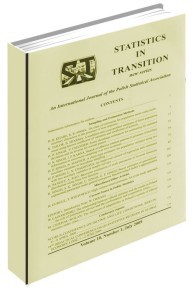Multi-State Markov Model: an Application to Liver Cirrhosis
Multi-State Markov Model: an Application to Liver Cirrhosis
Author(s): Gurprit Grover, V. Sreenivas, Sudeep Khanna, Divya SethSubject(s): Economy
Published by: Główny Urząd Statystyczny
Keywords: illness-death model;maximum likelihood;Cirrhosis;Hepatocellular Carcinoma (HCC)
Summary/Abstract: The control and treatment of chronic diseases is a major public health challenge, particularly for patients suffering from liver disease. In this paper, we propose a frame to estimate survival and death probabilities of the patients suffering from liver cirrhosis and HCC in the presence of competing risks. Database of the admitted patients in a hospital in Delhi has been used for the study. A stochastic illness-death model has been developed describing two liver illness states (Cirrhosis and HCC) and two death states (death due to liver disease and death due to competing risk). Individuals in the study were observed for one year of life at any age xi. The survival and death probabilities of the individuals suffering from liver cirrhosis and HCC have been estimated using the method of maximum likelihood. The probability of staying in the cirrhotic state is estimated to be threefold higher than that of developing HCC (0.64/0.21) in one year of life. The probability of cirrhotic patient moving to HCC state is twice (0.21/0.11) the probability of dying due to liver disease. HCC being the severe stage, the probability of patient dying due to HCC is three times that of cirrhosis. Markov model proves to be a useful tool for analysis of chronic degenerative disease like liver cirrhosis. It can provide in-depth insight for both the researchers and policy makers to resolve complex problems related to liver cirrhosis with irreversible transitions.
Journal: Statistics in Transition. New Series
- Issue Year: 14/2013
- Issue No: 3
- Page Range: 429-442
- Page Count: 14
- Language: English

